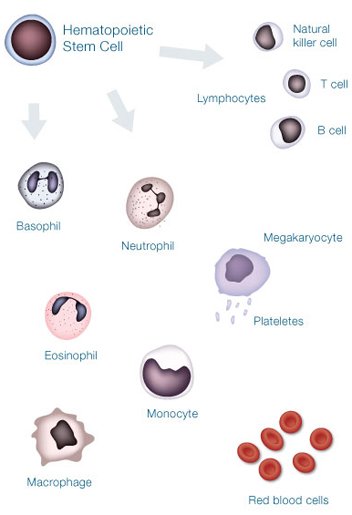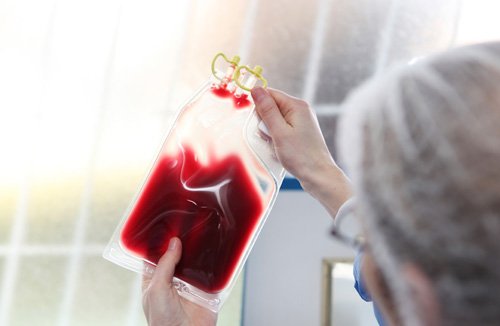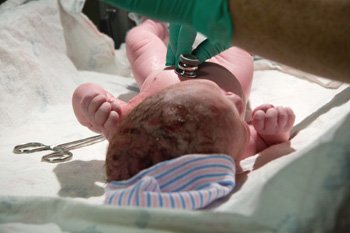In 1968, doctors performed the first successful bone marrow transplant. Bone marrow contains somatic stem cells that can produce all of the different cell types that make up our blood. It is transplanted routinely to treat a variety of blood and bone marrow diseases, blood cancers, and immune disorders. More recently, stem cells from the blood stream (called peripheral blood stem cells) and umbilical cord stem cells have been used to treat some of the same blood-based diseases.
Stem Cells in Use
Somatic Stem Cell Therapy: Using a Bone Marrow Transplant to Cure Leukemia
Leukemia is a cancer of white blood cells, or leukocytes. Like other blood cells, leukocytes develop from somatic stem cells. Mature leukocytes are released into the bloodstream, where they work to fight off infections in our bodies.
Leukemia results when leukocytes begin to grow and function abnormally, becoming cancerous. These abnormal cells cannot fight off infection, and they interfere with the functions of other organs.
Successful treatment for leukemia depends on getting rid of all the abnormal leukocytes in the patient, allowing healthy ones to grow in their place. One way to do this is through chemotherapy, which uses potent drugs to target and kill the abnormal cells. When chemotherapy alone can't eliminate them all, physicians sometimes turn to bone marrow transplants.
In a bone marrow transplant, the patient's bone marrow stem cells are replaced with those from a healthy, matching donor. To do this, all of the patient's existing bone marrow and abnormal leukocytes are first killed using a combination of chemotherapy and radiation. Next, a sample of donor bone marrow containing healthy stem cells is introduced into the patient's bloodstream.
If the transplant is successful, the stem cells will migrate into the patient's bone marrow and begin producing new, healthy leukocytes to replace the abnormal cells.
New evidence suggests that bone marrow stem cells may be able to differentiate into cell types that make up tissues outside of the blood, such as liver and muscle. Scientists are exploring new uses for these stem cells that go beyond diseases of the blood.

Peripheral Blood Stem Cells

While most blood stem cells reside in the bone marrow, a small number are present in the bloodstream. These peripheral blood stem cells, or PBSCs, can be used just like bone marrow stem cells to treat leukemia, other cancers and various blood disorders.
Since they can be obtained from drawn blood, PBSCs are easier to collect than bone marrow stem cells, which must be extracted from within bones. This makes PBSCs a less invasive treatment option than bone marrow stem cells. PBSCs are sparse in the bloodstream, however, so collecting enough to perform a transplant can pose a challenge.
Umbilical Cord Blood Stem Cells
Newborn infants no longer need their umbilical cords, so they have traditionally been discarded as a by-product of the birth process. In recent years, however, the stem-cell–rich blood found in the umbilical cord has proven useful in treating the same types of health problems as those treated using bone marrow stem cells and PBSCs.
Umbilical cord blood stem cell transplants are less prone to rejection than either bone marrow or peripheral blood stem cells. This is probably because the cells have not yet developed the features that can be recognized and attacked by the recipient's immune system. Also, because umbilical cord blood lacks well-developed immune cells, there is less chance that the transplanted cells will attack the recipient's body, a problem called graft versus host disease.
Both the versatility and availability of umbilical cord blood stem cells makes them a potent resource for transplant therapies.
